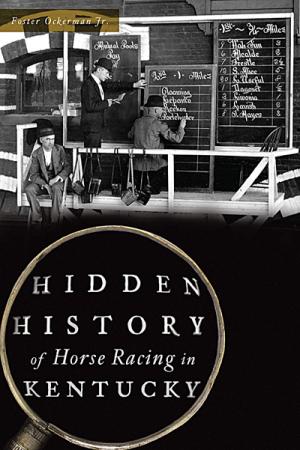Review by Nancy Brannon
Horse racing and the Commonwealth of Kentucky are synonymous, and May seems the appropriate month to read this book as preview to the Kentucky Derby. Author, historian, and Lexington native Foster Ockerman, Jr. details the rich and the lesser-known history about Thoroughbred racing in the Bluegrass State.
The equine industry in the state dates as far back as the eighteenth century. The Seventeenth Earl of Derby, Edward Smith-Stanley, made the trip from England to Louisville for the famed Kentucky Derby, first run on May 17, 1875, two days before The Oaks, which was named after his country estate.
But go back to the beginning and you’ll find that “the return of the Stuarts to the throne in 1669 with Charles II marked…the beginnings of the modern era of horse racing.” (p.13). A two-mile track on Long Island, NY called Newmarket is considered the birthplace of racing in this country.
In this book you’ll learn how jockeys’ silks evolved from coats of arms and crests worn by heraldry and armored knights in the Middle Ages, as well as origins of the word jockey to mean rider, also meaning to move around for a better position.
Hoyt Clay Pruett is credited by the Lexington Herald Leader with inventing the electronic starting gate in 1973. But following a similar article in the Daily Racing Form in 1994, a descendant of Marshall Cassidy asserts that Cassidy invented the modern gate. Today, there are two kinds of gates, the United Gate with flat front doors and the Pruett Gate with V-shaped doors.
The centerpiece of the book is the chapter on America’s first professional athletes: African-American jockeys. After emancipation these highly skilled jockeys came to dominate the sport of Thoroughbred racing and were very successful riders. Among the multiple winners of the Kentucky Derby were: Oliver Lewis; Isaac Murphy; James Winkfield – the only African American to win the Derby in the 20th century; James “Soup” Perkins; Willie Simms; and Alonzo “Lonnie” Clayton. But with the Plessy vs. Ferguson Supreme Court decision (1896) upholding segregation, and the spate of Jim Crow laws that were passed in the south, drove African-American jockeys out of racing.
Driving enthusiasts will enjoy the chapter on McDowell Speedway, detailing the evolution of four-wheeled carriage races to the Marathon in today’s combined driving events.
There’s a chapter on discerning the difference between bet, wager, and gambler; and how fixed-odds betting was replaced by pari-mutual betting.
There are chapters on how the Triple Crown came to be; on various tracks around Kentucky that no longer exist; and on famous horse farms that have since given way to subdivision development.
There is information about the founding fathers’ involvement with Thoroughbred breeding and racing. And there’s a full chapter on Henry Clay and his stallion Buzzard. In fact, “every one of the horses running in the 2017 Kentucky Derby, including the winner Justify, can claim lineage from Buzzard.”
My one complaint about this book is its need of better editing. As an editor myself, the misspellings, redundancies, and misplaced paragraphs stand out like a sore thumb. Other than that, it makes for interesting reading for Thoroughbred racing month.
About the author: Foster Ockerman Jr. is a Lexington, Kentucky native and seventh-generation Kentuckian. He is a practicing attorney, as well as a historian and the author of five histories, including the most recent history of Lexington. His law practice over the past forty years has covered business, real estate, nonprofit organizations, healthcare and equine law. In addition, he is president and chief historian for the Lexington History Museum Inc.
Horse racing and the Commonwealth of Kentucky are synonymous, and May seems the appropriate month to read this book as preview to the Kentucky Derby. Author, historian, and Lexington native Foster Ockerman, Jr. details the rich and the lesser-known history about Thoroughbred racing in the Bluegrass State.
The equine industry in the state dates as far back as the eighteenth century. The Seventeenth Earl of Derby, Edward Smith-Stanley, made the trip from England to Louisville for the famed Kentucky Derby, first run on May 17, 1875, two days before The Oaks, which was named after his country estate.
But go back to the beginning and you’ll find that “the return of the Stuarts to the throne in 1669 with Charles II marked…the beginnings of the modern era of horse racing.” (p.13). A two-mile track on Long Island, NY called Newmarket is considered the birthplace of racing in this country.
In this book you’ll learn how jockeys’ silks evolved from coats of arms and crests worn by heraldry and armored knights in the Middle Ages, as well as origins of the word jockey to mean rider, also meaning to move around for a better position.
Hoyt Clay Pruett is credited by the Lexington Herald Leader with inventing the electronic starting gate in 1973. But following a similar article in the Daily Racing Form in 1994, a descendant of Marshall Cassidy asserts that Cassidy invented the modern gate. Today, there are two kinds of gates, the United Gate with flat front doors and the Pruett Gate with V-shaped doors.
The centerpiece of the book is the chapter on America’s first professional athletes: African-American jockeys. After emancipation these highly skilled jockeys came to dominate the sport of Thoroughbred racing and were very successful riders. Among the multiple winners of the Kentucky Derby were: Oliver Lewis; Isaac Murphy; James Winkfield – the only African American to win the Derby in the 20th century; James “Soup” Perkins; Willie Simms; and Alonzo “Lonnie” Clayton. But with the Plessy vs. Ferguson Supreme Court decision (1896) upholding segregation, and the spate of Jim Crow laws that were passed in the south, drove African-American jockeys out of racing.
Driving enthusiasts will enjoy the chapter on McDowell Speedway, detailing the evolution of four-wheeled carriage races to the Marathon in today’s combined driving events.
There’s a chapter on discerning the difference between bet, wager, and gambler; and how fixed-odds betting was replaced by pari-mutual betting.
There are chapters on how the Triple Crown came to be; on various tracks around Kentucky that no longer exist; and on famous horse farms that have since given way to subdivision development.
There is information about the founding fathers’ involvement with Thoroughbred breeding and racing. And there’s a full chapter on Henry Clay and his stallion Buzzard. In fact, “every one of the horses running in the 2017 Kentucky Derby, including the winner Justify, can claim lineage from Buzzard.”
My one complaint about this book is its need of better editing. As an editor myself, the misspellings, redundancies, and misplaced paragraphs stand out like a sore thumb. Other than that, it makes for interesting reading for Thoroughbred racing month.
About the author: Foster Ockerman Jr. is a Lexington, Kentucky native and seventh-generation Kentuckian. He is a practicing attorney, as well as a historian and the author of five histories, including the most recent history of Lexington. His law practice over the past forty years has covered business, real estate, nonprofit organizations, healthcare and equine law. In addition, he is president and chief historian for the Lexington History Museum Inc.








